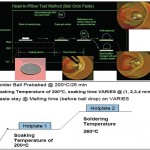In this article we share the solution for the elimination of head-in-pillow (HIP) defects in the package-on-package (PoP) assembly process by engineering unique attributes in the flux chemistries of dipping fluxes and pastes. Package-on-package technology is increasingly used in tightly packed electronic devices such as mobile gear and others. The HIP defect, which is characterized by the non-coalescence of the BGA ball with the solder paste deposit, is a very critical manufacturing issue because it is difficult to detect even with advanced X-ray algorithm systems.
Eugene Davies & Cristian Tudor, Indium Corporation, Milton Keynes, UK
The location of the defect mechanism is such that in a PoP device, a stacked configuration of single components (3D), the HIP fault is compounded because there are two planes in the device where the flaw can manifest itself: first, between the bottom stack and the PCB substrate, and second, between the top stack and the bottom stack. Experience from the field shows that most HIP faults occur on the bottom package to the board interface.
Apart from component warpage, oxide formation on the molten solder (solder paste and the BGA solder ball) during reflow will prevent the coalescence of the molten BGA ball with molten solder paste. From the standpoint of a flux chemistry designer, the key flux attribute is the intentional addition of a unique oxidation barrier that proactively prevents oxide formation, as opposed to the traditional reactive approach that uses very aggressive fluxes to reduce oxides that have already formed. Another flux attribute that can prevent HIP defects includes an optimized rheology to maximize the volume of flux and paste transferred during PoP printing or dipping. This means that more flux is available during reflow, which is especially important for fine-pitch packages (considering the mechanism of solder surface area to flux volume ratio). Additionally, a low slump flux rheology prevents the BGA ball from losing contact with the solder paste, even though the viscosity decreases as the reflow temperatures increase.
Mechanism of HIP defects during reflow processing
The formation of HIP faults during the reflow process shows that the BGA ball has complete contact with the wet paste. As the temperature increases, due to component warpage, the BGA ball loses contact with the paste. Oxide steadily builds up on the surfaces of the solder ball and the metallic solder particles of the paste. The formation of oxide is an exponential function of temperature. After the onset of the liquidus temperature, the package reverts back to its original shape. The molten BGA ball and the molten paste now try to coalesce because of surface tension, but the surface oxide prevents coalescence. The BGA ball and the solder paste eventually solidify as two separate entities, thus preventing the formation of a homogenous BGA solder joint. As shown in the graphic, the solid BGA ball may be in physical contact with the reflowed paste deposit and therefore may pass electrical testing indeed, but the electronic product can certainly fail once out in the field. This is what makes the HIP defect so deadly.
With shrinking PCB real estate and the need for more functionality, PoP has become a part of mainstream PCB assembly. In the figure we can see the sequence of the PoP assembly process and where the HIP defect can occur in the PoP stack. Both dipping fluxes and dipping pastes are used for the bottom and top stacks in PoP assembly. The HIP fault can happen in two different device planes in the PoP stack: between the substrate and bottom stack; and between the top stack and bottom stack.
Specific to the issue of HIP defects between the top and bottom stack, a newly formulated dipping paste that allows for solder particles to transfer to the BGA ball can better compensate for increased warpage by bridging the gap, as opposed to a standard dipping flux. In the dipping paste process, the PoP stack is dipped into the paste to cover about 50 to 75% of the solder ball, which ensures sufficient ball coverage. The dwell time while dipping is also an important parameter. Longer dwell times allow the dipping paste to adhere better to the component balls.
A more complex PoP component is the through-molded-via (TMV) package shown in the figure. This is where two planes of balls need to coalesce and form a homogenous joint. A HIP defect in such a TMV package, also called the “snowman effect,” is yet a bigger challenge due to the finer pitches and spacing involved. Here the flux chemistry becomes even more critical. See the other figure for the snowman effect in a TMV package.
Engineering flux chemistry to eliminate HIP defects
Two flux approaches can be used to address the oxide issue (that prevents coalescence of the BGA ball with solder paste) during reflow and thus prevent HIP faults. The traditional reactive method is to increase the activator content and make the flux more aggressive, reducing oxides remarkably. The problem with this flux chemistry is that oxides are allowed to form in the first place. Also, increasing the activator package can lower the surface insulation resistance (SIR) of the flux. This could become a serious issue with large, heavy thermal mass boards that may not see enough heat during reflow and, therefore, the no-clean flux may not get completely activated. However, unactivated flux can certainly cause electromigration and corrosion. Starting off with a flux that has a lower SIR, and the potential for unactivated flux causing electromigration, would be a double whammy, limiting the manufacturing process window significantly.
The proactive approach, on the other hand, involves engineering a unique oxidation barrier constituent into the flux. This barrier prevents or minimizes, respectively, the oxygen from reacting with solder and forming the unwanted oxides. This is especially important for the solder particles in a dipping paste used in PoP assembly that involves T5/T6 powder type that are just 5 to 20 microns in diameter. The combined surface area of the numerous solder particles translates to a significant potential for oxidation versus the large BGA ball. Until the point of coalescence between the molten ball and the molten paste, the oxidation barrier is designed to protect the solder (BGA ball and metal particles in the paste) from oxidation. At the point of coalescence, the oxidation barrier, having done its job, gets out of the way then, and the surface tension of the molten solder helps achieve coalescence and to shape a homogenous solder joint. In addition, to preventing oxide formation, this technology does not rely on beefing up the activator content, and so the necessary high flux SIR value can be attained. This significantly widens the reflow soldering window for high thermal mass boards by reducing the possibility of corrosion due to potentially unactivated flux.
Have a look at a possible worst-case scenario: the test to check for coalescence and the flux oxidation barrier by inducing oxide with a combination of long soak times and time-above-liquidus. An oxidized SAC ball is checked for coalescence with SAC solder paste on a hot plate (subject to varying soak times and time-above-liquidus). The other figure shows the coalescence results for different flux chemistries undergoing different conditions for soak time and time-above-liquidus. Factors included halogen-containing fluxes, halogen-free fluxes, and different oxidation barrier designs. It was found that the oxidation barrier design was the key differentiator. Also, as the profile became harsher, halogen-free fluxes had a smaller window compared to halogen-containing fluxes.
In a nutshell: regarding the flux material, the superior oxidation barrier in the flux chemistry is the key to proactively eliminating HIP defects in PoP assemblies and achieving homogeneous solder joints. This is applicable to both dipping fluxes and dipping pastes for the top and bottom stacks of the PoP.
Productronica, Booth A4.402
Zusammenfassung
Zunehmend werden in kompakten Geräten immer dichter integrierte Bausteine wie Package-on-Package (PoP) verwendet. Doch kommt es hier zu Head-in-Pillow (HIP) Defekten bei denen sich während des Reflows nicht die BGA-Balls mit dem Lotdepot auf dem Substrat verbinden und somit keine homogene Lötstelle bilden. Diese Fehler lassen sich selbst mit Röntgensystemen nur schlecht diagnostizieren und sind oft der Grund für teure Ausfälle beim Geräte-Anwender. Doch mit einem neuartig formulierten Flussmittel, das bis zum Liquidus die Oxidbildung zuverlässig verhindert und dann dieser Bestandteil daraus verschwindet, gibt es nun eine Lösung für dieses Problem.
De plus en plus on utilise dans les appareils compacts, des éléments intégrés de manière de plus en plus dense comme les Package-on-Package (PoP). Mais on obtient alors des pannes Head-in-Pillow (HIP) pour lesquelles durant le Reflow, les BGA Balls ne s’associent pas avec le dépôt de soudure sur le substrat et ne constituent par conséquent pas de point de soudure homogène. Même avec des systèmes à rayons X, il est toujours difficile de diagnostiquer ces défauts et ils sont souvent la cause de pannes coûteuses pour l’utilisateur des appareils. Mais avec un produit liquide issu d’une formule nouvelle qui empêche jusqu’au liquidus la formation d’oxyde de manière fiable et fait en sorte qu’ensuite cette composante disparait, il existe désormais une solution pour remédier à ces problèmes.
Share:
















